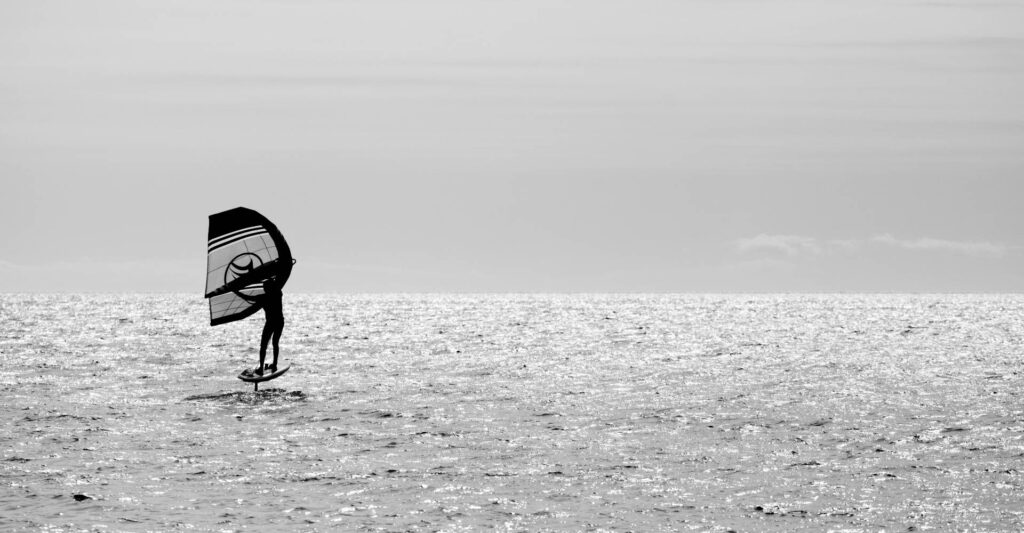Jibing in wingfoiling can be challenging to learn due to the dynamic nature of the sport. Mastering the jibe requires a combination of precise board control, wing handling, and body positioning. Wing foilers must synchronize their movements while maintaining balance on the board, making it a demanding manoeuvre that requires practice and coordination. Additionally, factors such as wind strength, water conditions, and rider experience can influence the difficulty of the jibe. However, with perseverance and dedication, riders can overcome the learning curve and experience the exhilaration of smoothly carving through turns on the water. Read how on this page as we go into the subject: Wingfoil how to jibe.
Also see other interesting wingfoil tutorials, such as how to take off and how to maintain flight longer. And don’t forget to read beginners tips and how to avoid beginner mistakes.
Here’s a step-by-step tutorial on Wingfoil how to jibe
Please note that in this tutorial, you change your stance (switch your feet) after turning. Another option is to switch your feet before committing to the jibe. This means you switch your stance well before going into the jibe and you ride your last meters before the jibe in a toeside position. The advantage is that during the jibe, you turn towards the more comfortable position (heelside) and you don’t need to switch feet during the jibe anymore.
Step 1: Find the right spot
Choose a wide and open area on the water with enough space for manoeuvring. Avoid crowded spots and obstacles to ensure safety during the jibing process. It’s a big step in wingfoil. How to jibe is something you learn with enough space around you.
Step 2: Get into the right position
Approach the jibe with good speed and keep your body centered on the board. Ensure your front foot is in the foot strap and your back foot is placed on the tail for better control.
Step 3: Start the turn
Begin your turn by shifting your weight slightly forward while slightly lifting the front wing. This will help initiate the turn smoothly and prevent the wing from stalling.
Step 4: Rotate your body
As you initiate the turn, rotate your body towards the new direction you want to go. Keep your eyes on the direction you want to jibe and maintain a low stance with bent knees for stability.
Step 5: Carve the board
Carve the board through the turn by applying pressure on the back foot to control the tail’s direction. Use your toes and heels to guide the board in the desired direction smoothly.

Step 6: Sheet out the wing
As you complete the turn, sheet out the wing to reduce its power. This will help you maintain balance and control while changing directions.
Step 7: Change hand position
While sheeting out the wing, change your hand position on the boom. Release your front hand, move it across the body, and grab the other side of the boom to prepare for the new side of the wing. You are almost there in your journey of wingfoil how to jibe!
Step 8: Sheet in the wing
As the board completes the turn and you’re ready to go in the new direction, sheet in the wing to regain power. This will allow you to pick up speed and continue gliding smoothly.
Step 9: Adjust your stance
As you complete the jibe, adjust your stance to a centered position on the board. Keep your body low and stable to maintain balance and control throughout the ride.
Step 10: Practice and refine
Jibing in wing foiling requires practice and patience. Take your time to practice the jibe in different wind and water conditions. Analyse your technique, make adjustments as needed, and keep refining your jibing skills to become a more proficient wing foiler.
Some handy links to other jibe tutorials
Remember, learning to jibe takes time and practice, so don’t be discouraged if it takes a few attempts to master this manoeuvre. With dedication and determination, you’ll soon be smoothly transitioning from one direction to another, adding a new dimension of excitement to your wingfoiling adventures.
It’s also good to watch many tutorials about jibing, so here are two very good ones for you.
